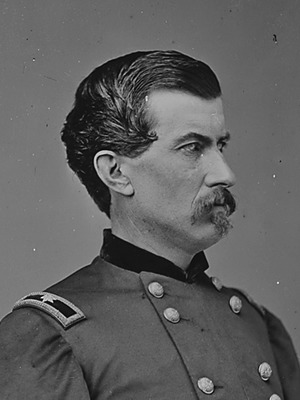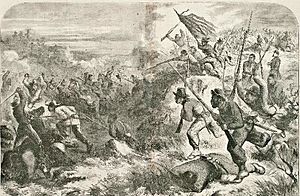James Monroe Williams facts for kids
Quick facts for kids
James Monroe Williams
|
|
|---|---|
 |
|
| Born | September 12, 1833 Lowville, New York |
| Died | February 15, 1907 (aged 73) Washington, D.C. |
| Buried | |
| Allegiance | United States of America Union |
| Service/ |
United States Army |
| Years of service | 1861–1865, 1866–1873, 1891 |
| Rank | Colonel Brevet Brigadier General |
| Commands held | 1st Kansas Colored Infantry Regiment 79th United States Colored Infantry Regiment |
| Battles/wars | American Civil War |
| Other work | lawyer, rancher, merchant |
James Monroe Williams (born September 12, 1833 – died February 15, 1907) was an American lawyer, soldier, and businessman. He was an officer in the Union Army during the American Civil War. He became a high-ranking officer, a brigadier general, by the end of the war.
Williams was also very important because he helped create and lead the 1st Kansas Colored Infantry Regiment. This was the first group of African American soldiers in the Union Army to fight in a battle. After the war, Williams continued to be a soldier for a while. Later, he became a rancher and then a merchant.
Early Life of James Williams
James M. Williams was born in 1833 in a town called Lowville, New York. He later became a lawyer in New York State.
Williams's Service in the Civil War
On July 12, 1861, James Williams joined the Union Army. He started as a captain in the 5th Regiment Kansas Volunteer Cavalry. He was put in charge of Company F. This group was formed in Leavenworth, Kansas, during the summer and into January of the next year. Williams and his regiment served in the Kansas area until June 1862. Then, they moved to the Missouri area in July.

In the fall of 1862, Williams left the 5th Kansas Cavalry. He wanted to help create and train the 1st Kansas Colored Infantry Regiment. This group was put together in August at Fort Scott, Kansas. Williams was made its commander as a state militia colonel.
He led his regiment into battle on October 29 during the Skirmish at Island Mound. This battle happened in Bates County, Missouri. It was the first time African American soldiers in the Union Army fought in a real battle.
On January 13, 1863, Williams became a lieutenant colonel when his regiment officially joined the federal army as the 79th United States Colored Infantry Regiment. On May 2, Williams was promoted to the rank of colonel. From July 1–2, he fought at the Battle of Cabin Creek in the Indian Territory. About two weeks later, he led his regiment during the Battle of Honey Springs. Williams was wounded in this fight.
In December 1863, Williams was given command of Roseville, Arkansas. He took part in the Camden Expedition in southern and central Arkansas from March 23 to May 2, 1864. He then led different groups of soldiers at various times for the rest of 1864 and into the fall of 1865. Williams also fought at the Battle of Fort Smith in western Arkansas on July 31, 1864.
After the War
On October 1, 1865, Williams finished his service as a volunteer soldier. On July 28, 1866, he became a captain in the new 8th Cavalry Regiment of the regular army. He was in charge of Company I. The 8th Cavalry was first based at Fort Whipple, Arizona. Later, they were stationed at Fort Selden and Fort Bayard in the New Mexico Territory.
Williams was given the honorary rank of major on July 9, 1867. This was for his service during the American Indian Wars. He left the army on March 29, 1873. After that, he started working as a rancher in the Colorado Territory.
Williams joined the army again almost twenty years later. He became a captain in the 7th Cavalry Regiment on January 7, 1891. He retired five days later to become a merchant. Williams died in Washington, D.C., on February 15, 1907. He was buried with full military honors in Arlington National Cemetery in Virginia.

